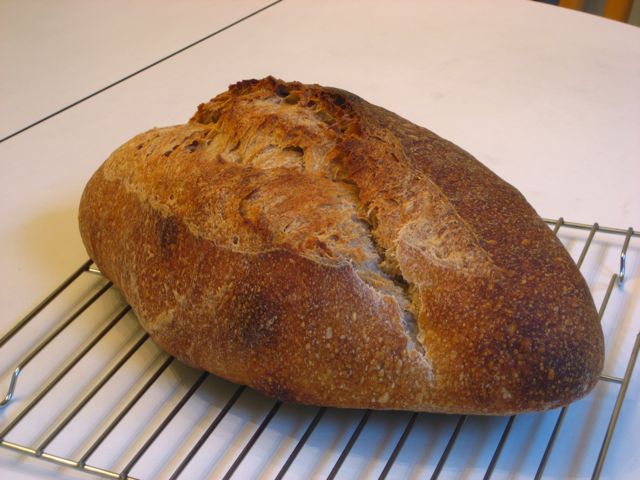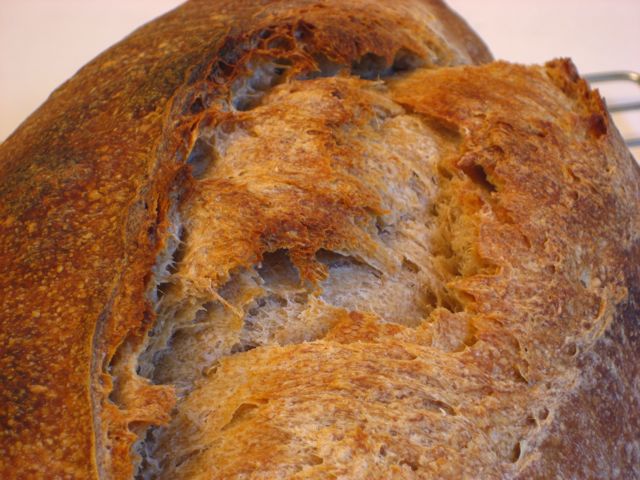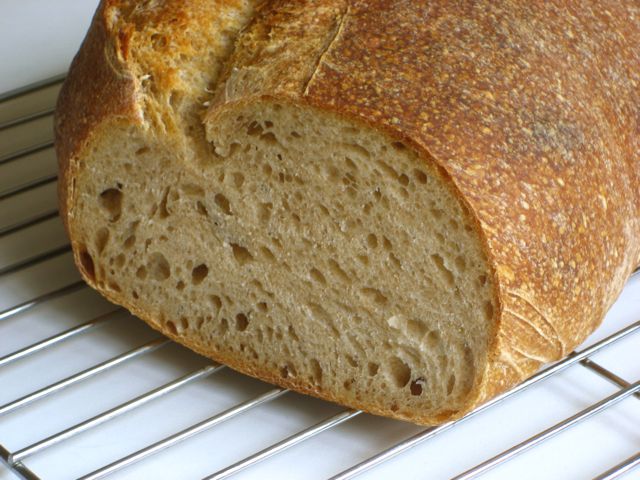I have posted this recipe, more or less, elsewhere, but I am recording it in my blog for posterity, with some updates to my process and my thinking:
Again, this isn't a recipe for the baker who prefers precise measurements!
This is a two levain naturally leavened bread, based on Joe Ortiz' recipe from The Village Baker but modified so that, well, to be blunt, it works which the original doesn't really. The only substantive change is at the beginning, rather than starting a chef from scratch and expecting to get a sufficiently active culture to raise a loaf, I start with a liquid-ish starter.
My "storage starter" is a all whole wheat starter, fed every 2 days and kept at the consistency of mayonnaise, more or less. I use a pinch of salt in it to slow it down a little more. I use it often enough to keep it out of the fridge, but not often enough to want it sitting around eating its head off all day! So, I keep it a little hungry, and a little slow.
Step 1
Feed my starter. If I'm planning to start the next day, I make sure to feed my starter the night before so that it's pretty active the next evening. I could probably improve this by feeding the morning of, and getting the first levain started in the evening. Anyways, making sure the starter is pretty active is important -- the levains will be lethargic and slow to work otherwise.
Step 2
First levain:
- approximately 1 oz liquid starter (2 tablespoons)
- approximately 1 oz water
- 2-3 oz whole wheat flour
I vary this according to how active my liquid starter is. If it seems a little sleepy, I will make this levain a bit larger AND use a higher percentage of starter in it. You're looking for 4 to 5 ounces of stiff dough here. It should feel like a regular american bread dough (say 50% hydration or so). I cover the bowl with plastic wrap, which keeps a crust from forming. I think it you cover with cloth, you may get a crust, which you might want to discard -- if so, make the levain bigger to you have some extra to discard!
In any case, use amounts of flour and water as indicated, but in ratios such as to give this stiff dough. The hydration of your starter will affect things as well, of course. I think that, based on the level of activity of your starter:
- use 2 oz flour, and 2 tablespoons starter if Very Active
- use 3 oz flour, and 3 tablespoons starter if Kind of Sleepy
- use something in between if your starter is somewhere in between
Then add water sufficient to make a stiff dough. I use 'the fountain' method which seems to give pretty good control here, but I have also just mixed all the stuff in a bowl as well. Knead a bit for some little development, but don't worry much about that at this point.
This rises overnight, 8 to 12 hours. Again, if the initial starter seemed sleepy, I might give it 12 hours. It will become soft and inflated, at least doubling. One test I have seen and used for ripeness is 'does it float' (or does a little piece snipped off and not degassed much float). When you deem this levain ripe:
Step 3
Second levain (the next morning):
- all of the first levain
- 2.5 to 3.5 ounces of water
- 5 to 7 ounces, total, of flour -- equal parts whole wheat and white bread flour
At this point, again, the size of the second levain will be determined by how sleepy the first levain seems, and how big it was. If the first levain still seems a little slow, I'll mix the second levain smaller (to have a higher percentage of first levain in it -- I could make the first levain "richer" by adding more liquid starter, but at this point you're stuck with the first levain as-is, so the way to enrich is to actually mix smaller). The result will be 12 to 16 ounces of levain, again mixed quite stiff.
You'll cut the first levain up in to bits, and let them soak in the water (use maybe 2 ounces of water, 1/4 cup, for this), and then add flour as you think best to mix a smaller or larger levain (5 ounces flour if the first levain is Kind of Sleepy, 7 ounces if Very Active, and in between if in between) and then add water as necessary to get a stiff dough. Kneading this to get a little more dough development is probably worthwhile, as we'll be making up dough and baking today, most likely.
This rises for 4 to 6 hours, until doubled or so. You can use the float test here as well.
It should be about mid-day at this time.
Step 4
Final dough:
- all of the second levain
- 12 to 16 ounces of white bread flour
- 8 to 11 ounces of water
- 1 tablespoon salt or less
Break up the second levain into 1 cup (8 oz) of water and let soak, add in appropriate flour. As usual:
- if the second levain seems sleepy, use less flour (12 ounces, you're going to bake a smaller loaf)
- if it seems active and excited, use more flour (16 ounces, hooray, you get a bigger loaf)
- if your second levain is somewhere in the middle, use somewhere in the middle!
Adjust salt. A tablespoon is good for the larger loaf, reduce it proportionately (probably never below 2 teaspoons).
Add water sufficient to make a wetter dough than the levains, but not a "wet" dough as such. 60% hydration, maybe. It will get wetter as it proofs, so err on the side of 'stiff'! If the levains have been slow and sleepy, mix this stiffer since you'll be proofing longer, and if you feel like you've got a vigorous and excited culture, you can go a little wetter. Knead thoroughly. It should windowpane, but perhaps not very well, as you'll be proofing for a while. I proof for a couple of hours, with a stretch and fold every hour or thereabouts.
Shape your loaf, and let proof until ready (poke test -- I use 'poke it gently, making a hole 1/4 to 1/2 inch deep; the hole should slowly refill, being mostly gone after several seconds').
Bake at 425 or thereabouts suitable to the loaf size and shape, with steam. I use 40 minutes for the "smaller" loaf shaped as a batard, and 50 minutes for a full-size boule (when I am able to mix the "full sized" loaf). You could probably bake it hotter and faster if you liked!
Pictures below are the batard, with levains mixed at, roughly: 5 ounces, 15 ounces, and final dough at around 35 ounces (probably baked down to 30 ounces or less):



- amolitor's Blog
- Log in or register to post comments
It looks as though you got a lot of oven-spring with this bake. And I like the rich coloration of the crust. It must taste wonderful.
Paul